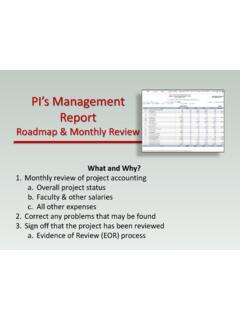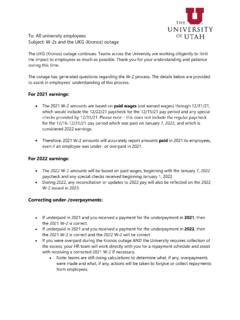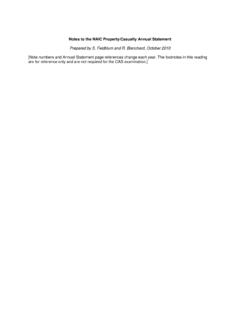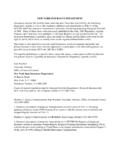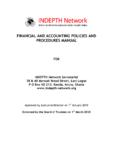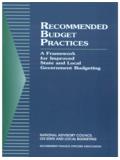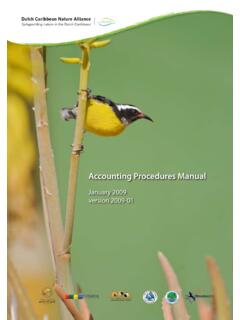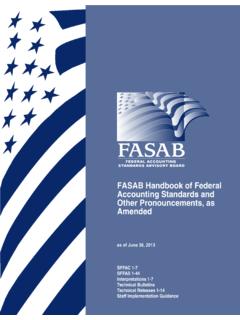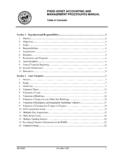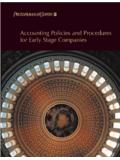Transcription of Best Practices for Cash Control
1 INCOME accounting & STUDENT LOAN SERVICESBest Practices for Cash ControlThe procedures listed below are the best Practices to accept, store, reconcile and deposit, document, and transport deposits, for cash, checks and payment cards. There are several steps to ensure that all cash is handled securely, so please review each section. Handling and Safeguarding Cash Accepting Payments Petty Cash Reconciliation Preparing and Booking Deposits to General Ledger Separation of Duties Dual Controls Transporting Cash Overages and Shortages Counterfeit MoneyHandling and Safeguarding Cash All cash, checks, and payment cards, should be kept in a locked/combination vault or safe, or, in a locked room in a locked drawer or le cabinet, during non-business hours.
2 Access to areas where cash is stored should be limited to only those employees who need access, and have been designated to have access. During business hours, all forms of cash should be stored in locking drawers, cash registers, and cash boxes. Only the cashier collecting these monies should Control over this cash, and make sure that the cash is securely locked when they take lunch, or a break. The cashier should have complete Control and responsibility for the cash they collect during business hours.
3 To reduce the risk of error, all cash should be separated according to the denomination, and should face the same direction. Checks should be kept together separately, and credit card receipts and any other documentation, should also be kept together separately. Credit card machines and the receipts should not be left unattended. They should be kept in an inaccessible area. When possible, areas that store cash should be alarmed during non-business hours. All types of cash should be deposited within 3 business Payments All types of payments should be input into an electronic device, such as a cash register or computer terminal, or tracked manually with pre-numbered receipts, to ensure that all payments are documented.
4 Payments for goods or services can be accepted in the form of cash and coin, checks, and payment cards. Payments can be received in-person, by mail, or armored car delivery. In-Person Cash and Coin, and Check Payments Accepted Manually: Payments accepted by departments without an electronic device should be tracked by pre-numbered receipts. When cash and coin payments are accepted as payment, they should always be recounted in front of the customer to con rm the amount received from the customer.
5 A receipt should always be given to the customer for cash payments. If change is given back to the customer, the change should be counted back to customer, to con rm that the correct amount is given back. Checks should be endorsed immediately. A completed receipt must be retained by the department. In-Person Cash and Coin Payments: When cash and coin payments are accepted as payment, they should always be recounted in front of the customer to con rm the amount received from the customer.
6 A receipt should always be given to the customer for cash payments. If change is given back to the customer, the change should be counted back to customer, to con rm that the correct amount is given back. Payments should be input, or rung in, on the cash register or computer terminal at the same time they are received. In-Person Check Payments: Payments should be input, or rung in, on the cash register or computer terminal, as they are received. Checks should be endorsed immediately.
7 A receipt should be given to customer. Mail Check Payments: All check payments should be logged daily. Payments should be input, or rung in, on the cash register or computer terminal, daily when they are received. Checks should be endorsed immediately. Armored Card Delivered Cash and Check Deposits: A log should be kept of all daily deposits received. All deposits should be counted daily and input into the cash register or computer terminal, daily when they are received. Checks should be endorsed immediately, if they have not been Cards: Payment cards can be accepted in-person, or by phone.
8 When accepting an in-person payment the cashier should look at the card to con rm that the card is signed, and belongs to the customer. The customer should always sign the payment card receipt, and the payment should be input, or rung in, on the cash register or computer terminal, when received. Phone payment card payments should be input, or rung in, on the cash register or computer terminal, daily when received. O ce receipts and any accompanying documentation should be kept secure. The receipts and accompanying documentation should never be thrown in the trash.
9 They should be destroyed within 18 months. A receipt should be given to the Cash Departments needing to provide change, or reimbursements should request a petty cash fund from General accounting . This cash should be counted daily and logged. When cash becomes depleted, a refund check should be requested by the petty cash custodian to Accounts Payable. This check can be cashed at the main Cashier s window in the Student Services Building, room In-Person and Mail Payments Input Into an Electronic Device: The Cashier should balance their money to their daily receipts, per the totals on their electronic devices.
10 The device should be closed out daily, and a grand total tally should be printed. Checks should be totaled with a calculator tape attached. Ensure that all checks are endorsed. Cash and coin should be totaled. The payment card machine should be closed out and settled, if applicable. Any petty cash should be deducted from the cash, if applicable. The remaining cash, the checks, and payment cards should balance to the amount of the daily receipt grand total. In-Person and Mail Payments Accepted Manually: The Cashier should balance their money to their daily receipts.



